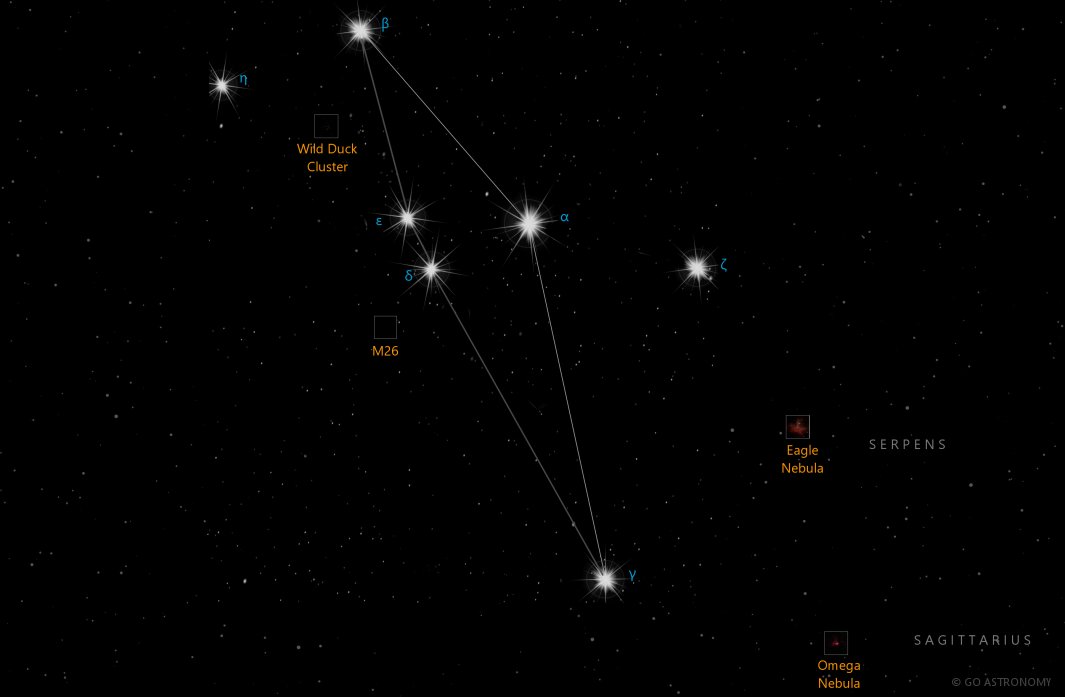Scutum, the Shield (Sct)
(SCOOT-um)
The Southern constellation of Scutum, the Shield, is best viewed in Summer during the month of August.
Scutum is the 84th largest constellation. It's brightest star is Alpha Scuti at magnitude 3.85. The boundary of the Scutum constellation contains 1 stars that host known exoplanets.
Scutum is an equatorial constellation, which means its bulk intersects the celestial equator or comes within 10-15 degrees of doing so. Scutum is visible from most places on Earth.
Red supergiant UY Scuti is the largest known star in the universe at 1,700 times the size of the Sun.
- Pronunciation:
- SCOOT-um
- Meaning:
- Shield
- Genitive:
- Scuti
- Abbreviation:
- Sct
- Constellation Family:
- Hercules
- Hemisphere:
- Southern
- Quadrant:
- SQ4
- Visibility:
- 80° N - 90° S
- Best viewing month*:
- August
- Area:
- 109 sq. degrees
- Size:
- 84th largest
- Equatorial:
- Yes
- Right Ascension (avg):
- 18h 39m
- Declination (avg):
- -10°
- Brightest star:
- Alpha Scuti (3.85)
- Stars with planets:
- 1
- X-ray stars:
- 4 (2 binaries) stars
- Caldwell objects:
- |
Brightest Stars in Scutum
The 10 brightest stars in the constellation Scutum by magnitude.
- Star
- Magnitude
- Spectral class
- Alpha Scuti (α Sct)
- 3.85
- K2III
- Beta Scuti (β Sct)
- 4.22
- G5II
- Zeta Scuti (ζ Sct)
- 4.66
- K0III
- Gamma Scuti (γ Sct)
- 4.67
- A1IV/V
- Delta Scuti (δ Sct)
- 4.70 (4.60–4.79)
- F2IIIp d Del
- Eta Scuti (η Sct)
- 4.83
- K1III
- Epsilon Scuti (ε Sct)
- 4.88
- G8II
- HD 175156
- 5.08
- B3II
- HD 171391
- 5.12
- G8III
- R Scuti (R Sct)
- 5.38 (4.5–8.2)
- K0Ibpvar
Star Clusters in Scutum
The most notable and easy-to-find star clusters in the constellation Scutum . Also see all star clusters.
- Star cluster
- Catalog #
- Cluster type
- Messier 26
- M26
- open
- NGC 6712
- globular
- Wild Duck Cluster
- M11
- open
The Shield of the Night Sky
Located in the fourth quadrant of the Southern Hemisphere, the Scutum constellation, Latin for "the shield", is a small but interesting constellation. Despite its modest size, it contains several fascinating deep-sky objects. This article will delve into the historical background, prominent features, celestial objects, and viewing guidance for the constellation Scutum.
Historical Background
Scutum was first introduced by the Polish astronomer Johannes Hevelius in the late 17th century. It was originally named 'Scutum Sobiescianum' after the Polish King John III Sobieski, in honor of his victory over the Ottoman Empire at the Battle of Vienna in 1683. However, over time the name was shortened to Scutum, simply meaning 'shield'.
Location and Visibility
Scutum, though small, is easy to find due to its location near the larger and more recognizable constellations Aquila, Sagittarius, and Serpens Cauda. Covering approximately 109 square degrees, it ranks 84th in size among the 88 recognized constellations. Its position in the Milky Way plane makes it a rich field for viewing nebulae and star clusters.
Notable Stars in Scutum
Scutum does not contain any exceptionally bright stars. Alpha Scuti, the brightest star in Scutum, is an orange giant star located roughly 174 light-years away from Earth. Beta Scuti, the second-brightest star, is a yellow giant around 690 light-years away. While these stars may not stand out in brightness, they contribute to the constellation's rich star field view.
Deep Sky Objects
The Scutum constellation is known more for its deep-sky objects than its stars. It contains a portion of the Scutum Star Cloud, one of the richest parts of the Milky Way. This area is packed with numerous stars and clusters, providing a beautiful view for stargazers with telescopes.
Scutum also hosts two notable open clusters: the Wild Duck Cluster (Messier 11) and the lesser-known NGC 6664. The Wild Duck Cluster, located approximately 6,200 light-years away, is one of the most densely packed open clusters known, with several thousand stars. NGC 6664, while not as dense, provides an intriguing view for amateur astronomers.
Observation
Best viewed during the months of July and August, Scutum is visible from most places on Earth, except for the far northern regions. Given its richness in stars and deep-sky objects, it provides an excellent viewing field for stargazers using binoculars or small telescopes. However, due to the constellation's dimness, it is best viewed from a location with minimal light pollution.
* Constellation shown for northen hemisphere skies. For the southern hemisphere, constellations appear rotated 180 degrees (upside-down and left-right reversed) from what is shown. Remember that seasons are reversed too - summer in northern latitudes is winter in southern latitudes.
** Circumpolar constellations are visible year-round in the hemisphere listed (and not at all in the opposite hemisphere).





